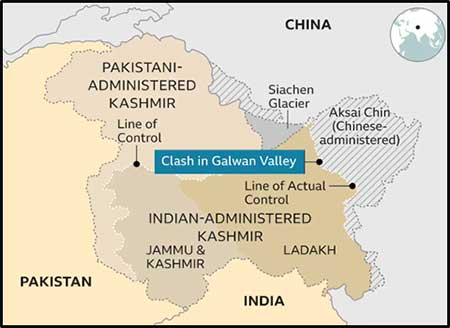Date : 20/06/2023
Relevance: GS Paper 2: Bilateral Relations
Main Words: `LAC, Buffer Zone, Belt and Road Initiative (BRI), Nuclear Suppliers Group (NSG), Galwan Clash
Context -
- The Galwan clash, a significant event in India-China relations, resulted in the deaths of 20 Indian soldiers, marking the first time Indian Army personnel were killed on the Line of Actual Control since 1975.
- Since then, both countries have engaged in multiple rounds of negotiations and managed to disengage at five "friction points" along the Line of Actual Control, establishing demilitarized buffer zones in those areas. However, there remain areas of cooperation and contention between India and China.
Areas of Cooperation:
- Political and Diplomatic Relations: Exchange of views and establishment of friendship groups between China and India.
- Economy and Trade: Growth in trade volume and bilateral economic cooperation between China and India.
- Investment & Banking: Opening of branches of Indian and Chinese banks in each other’s countries.
- E-business Visa: Introduction of a visa category to facilitate business travel between China and India.
- Science & Technology: Joint research workshops and promotion of cooperation in science and technology innovation.
- Defense: Joint anti-terrorist exercises and defense consultations to enhance mutual understanding and cooperation.
- People-to-People Exchanges: High-level meetings and cultural exchanges to strengthen people-to-people ties.
- Education Relations: Educational cooperation, scholarship programs, and exchange agreements between India and China.
Challenges:
- Chinese Initiatives: India's concerns and suspicions regarding Chinese initiatives like the Belt and Road Initiative (BRI) and Chinese presence in the Indian Ocean.
- Increasing Presence in the Indian Ocean: China's policy of building ports and naval bases in countries surrounding India's maritime reaches, which India sees as encirclement.
- Border Dispute: Disputed border areas between India and China, including the Western, Middle, and Eastern sectors.
- River Water Dispute: China's construction of dams in the upper reaches of the Brahmaputra River leads to concerns over water sharing.
- Dalai Lama and Tibet Issue: India's support for the Tibetan government in exile led by the Dalai Lama, is not acceptable to China.
- Presence in South Asia: China's increasing investments and trade with countries in South Asia challenge India's traditional influence in the region.
- Trade Imbalance: India's trade deficit with China indicates difficulties in competing with Chinese manufactured goods.
- China's Protectionist Policies: Obstacles faced by Indian companies in entering the Chinese market due to protectionist measures.
- China's Support to Pakistan: China's support for Pakistan through investments and backing on various issues affect India's relationship with Pakistan.
- Nuclear Suppliers Group (NSG): China's opposition to India's entry into the Nuclear Suppliers Group hinders India's nuclear ambitions.
- Digital Security: Concerns over Chinese investments in India's knowledge economy raise privacy and data security issues.
Persisting Issues:
The creation of buffer zones has raised concerns among Indian experts who view them as a loss of territory for India. These zones have allowed the Chinese to monitor Indian forces' movements and establish infrastructure in the region. In response, India has been rapidly developing its infrastructure.
Conclusion:
Despite ongoing engagement between the two sides, there remains a fundamental difference in their perspectives on the border issue. India insists that the border situation must be resolved before normalization of bilateral relations can occur, while China believes that the issues have been resolved and suggests moving forward.
Probable questions for Main Exam-
- Question 1: Analyze the impact of the Galwan clash on India-China relations and its implications for regional dynamics. Discuss the steps taken by both countries to address the conflict and evaluate their effectiveness. (10 marks,150 Words)
- Question 2: Assess the areas of cooperation and contention in India-China relations three years after the Galwan clash. Suggest policy measures that India can adopt to address these challenges and maintain a balanced approach toward its relationship with China. (15 Marks,250 Words)
Source: Indian Express






















